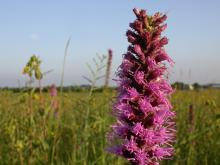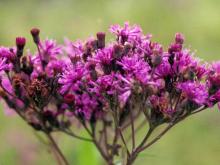Wildflowers, Grasses and Other Nonwoody Plants
Media

Species Types
Scientific Name
Veronicastrum virginicum
Description
Culver’s root is a tall, graceful perennial with flower clusters that look like candelabras. The white flowers are packed together in slender, brushlike spikes. The leaves are in whorls, well-spaced along the stalk.
Media

Species Types
Scientific Name
Symphyotrichum spp. (formerly Aster spp.)
Description
Missouri has 24 species of New World asters in genus Symphyotrichum. Most have purple or white ray flowers and yellow disk flowers that turn reddish over time. Most bloom in late summer and fall.
Media

Species Types
Scientific Name
Penstemon cobaea
Description
Cobaea beardtongue, or purple beardtongue, is probably Missouri’s showiest species of penstemon. Native to Missouri's southern Ozarks, it is grown statewide for its beauty, and because pollinators like it. It may be purple or white.
Media

Species Types
Scientific Name
Liatris spp.
Description
Missouri boasts nine native species of blazing stars, or gayfeathers, in genus Liatris. These showy, upright, unbranching spikes of magenta-pink wildflowers bloom in sunny habitats.
Media

Species Types
Scientific Name
Vernonia spp.
Description
Five species of ironweeds live in Missouri. Starting in the middle of summer, they bear showy clusters of magenta or purple flowerheads at the branching tops of upright stalks.
Media

Species Types
Scientific Name
Persicaria virginiana (formerly Polygonum virginianum)
Description
Virginia knotweed, or jumpseed, is common yet rarely contemplated. It might be most eye-catching in spring, when its new, oval leaves are marked with brownish Vs. In summer, it blooms with tiny, teardrop-shaped white flowers on wandlike stems.
Media

Species Types
Scientific Name
Trifolium pratense
Description
Red clover, or purple clover, is the familiar large, pinkish-purple clover that grows in lawns, pastures, and roadsides statewide. A Eurasian native, it was introduced to North America by the middle 1600s.
Media

Species Types
Scientific Name
Phlox divaricata
Description
A common, eye-catching native spring wildflower common in woodlands, blue phlox occurs nearly statewide.
Media

Species Types
Scientific Name
Phlox paniculata
Description
Perennial phlox has big, showy clusters of flowers. A tall, late-blooming native wildflower of woodland borders, steamsides, and gravel bars, it is also an old-fashioned garden favorite.
Media

Species Types
Scientific Name
Subfamily Asclepiadoideae
Description
Milkweeds are a group of plants that used to have their very own family. Now part of the dogbane family, they’re still a pretty distinctive group.
See Also
About Wildflowers, Grasses and Other Nonwoody Plants in Missouri
A very simple way of thinking about the green world is to divide the vascular plants into two groups: woody and nonwoody (or herbaceous). But this is an artificial division; many plant families include some species that are woody and some that are not. The diversity of nonwoody vascular plants is staggering! Think of all the ferns, grasses, sedges, lilies, peas, sunflowers, nightshades, milkweeds, mustards, mints, and mallows — weeds and wildflowers — and many more!





















